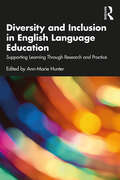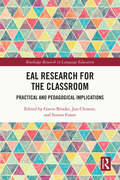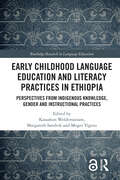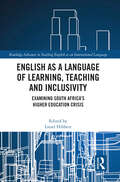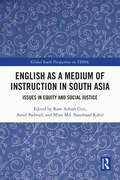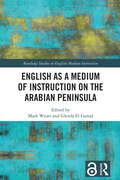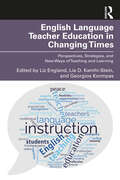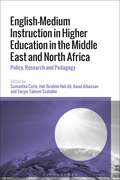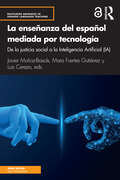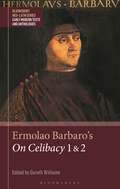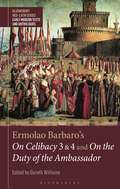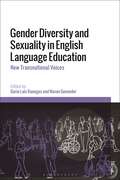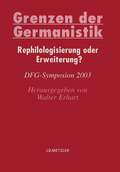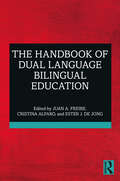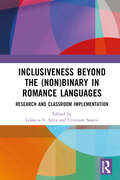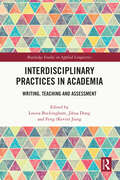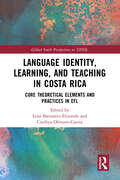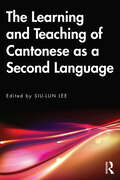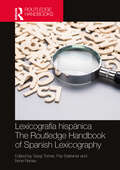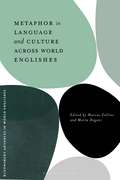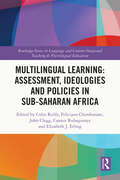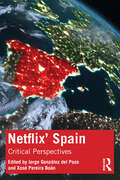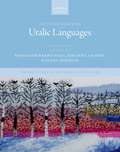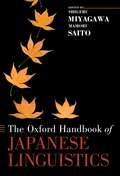- Table View
- List View
Diversity and Inclusion in English Language Education: Supporting Learning Through Research and Practice
This edited volume takes an expansive, no-nonsense view of the spectrum of English language learners to address their varied backgrounds and their wide range of needs, worries, motivations, and abilities. Each chapter addresses a key area and group of students to enable English language teachers to come away with the knowledge and skills they need to support their students. The contributors, who represent a diverse range of voices themselves, cover essential topics, including dyslexia, neurodiversity, linguistic inclusion, deaf students, LGBTQI+ students, racial and cultural inclusion, and more. Accessible and grounded in cutting-edge research, this book features key concepts, methodologies, and strategies that will encourage reflection and inclusive pedagogy. An invaluable resource for students, researchers, and professionals, this volume demonstrates how English language education can be a force for transformative change and social inclusion.
EAL Research for the Classroom: Practical and Pedagogical Implications (Routledge Research in Language Education)
With an estimated 1.6 million English as an Additional Language (EAL) learners in the UK, and over 5 million in the USA, EAL research is urgently needed to inform practice. This edited volume investigates the multifaceted elements that shape EAL pedagogy and research in a variety of settings and research areas including linguistic ability influences on subject-specific skills, integrating learners’ home languages into classroom environments, and the importance of supporting EAL teachers in the classroom. In doing so, the contributors provide an international perspective on the emerging field of EAL research. The research-based chapters detail fundamental concerns related to EAL learner education. The text is composed of three parts: Part 1 explores the question of what is EAL and how a definition can shape policy construction; Part 2 examines the challenges EAL learners face in the classroom, including the use of first languages and the relative impact learner language proficiency has on subject-specific classes; and Part 3 investigates concerns relating to supporting EAL teachers in the classroom. The volume draws on researcher expertise from a variety of universities and institutions worldwide. It explores diverse language backgrounds in multilingual contexts. It covers empirical studies with pedagogical, policy and further research implications. The volume represents a single resource invaluable for EAL teachers, trainers and trainees, as well as researchers in the field of education, language learning and teaching, bilingualism and multilingualism, and second language acquisition.
Early Childhood Language Education and Literacy Practices in Ethiopia: Perspectives from Indigenous Knowledge, Gender and Instructional Practices (Routledge Research in Language Education)
This edited volume explores how indigenous knowledges and practices can be instrumental in improving literacy outcomes and teacher development practices in Ethiopia, aiding children’s long-term reading, and learning outcomes. The chapters present research from a collaborative project between Ethiopia and Norway and demonstrate how students can be supported to think pragmatically, learn critically and be in possession of the citizenship skills necessary to thrive in a multilingual world. The authors celebrate multilingualism and bring indigenous traditions such as oracy, storytelling, folktales to the fore revealing their positive impact on educational attainment. Addressing issues of language diversity and systematic ignorance of indigenous literacy practices, the book plays a necessary role in introducing Ethiopia’s cultural heritage to the West and, hence, bridges the cultural gaps between the global north and global south. Arguably contributing one of the first publications on early literacy in Ethiopian languages, this book will appeal to scholars, researchers and postgraduate students studying the fields of early years literacy and language, indigenous knowledge and applied linguistics more broadly.
English as a Language of Learning, Teaching and Inclusivity: Examining South Africa’s Higher Education Crisis (Routledge Advances in Teaching English as an International Language Series)
Hibbert explores South Africa’s higher education crisis utilising case studies and first-hand experiences with English as the language of instruction. The historical overview provides a framework with which to understand the complicated nature of using English as a language of instruction in South Africa, past and present. Student narratives are presented to illustrate mainly breakthroughs, but also challenges. An overview is provided, of imported English teaching methodologies and how they have emerged and developed in the local educational system over decades. It is demonstrated how these methodologies relate to socio-economic and political events and trends at each juncture. By applying defamiliarisation as a research method of investigation, students’ translanguaging struggles are recorded and discussed, both pre-pandemic and in the pandemic period. The experiences of non-monolingual English-speaking staff and students, and of local English/African language bilinguals is foregrounded, as they are by far the majority in South African higher education and schools. The relevance of the experiences and learning paths of those staff and students is enhanced. This book aids lecturers across disciplines and English language facilitators in the improvement of English acquisition curricula through exposure to arguments, case studies and learning path narratives in this volume, and prompts and inspires researchers to develop further theories and experiments in their own context.
English as a Medium of Instruction in South Asia: Issues in Equity and Social Justice (Global South Perspectives on TESOL)
This book examines the ‘English mania phenomenon’ and the complex circumstances of adopting English Medium Instruction (EMI) by South Asian education systems and the effect of an uneven distribution of resources on the already under-resourced countries in the region. Chapters explore linguistic, social, and economic injustices by using an analytic-critical approach to examinations of the place, role, provisions, and practices of EMI in specific English language teaching (ELT) contexts. The book consequently advocates for the wholescale reform of a system, which, the authors argue, is unjust. Ultimately, the book explores socio-cultural, poststructuralist, and English linguistic imperialism theories to contribute a South Asian perspective on the controversy surrounding EMI and examine its role within a wider global discourse on equity and social justice. Critically examining the spread of English in South Asia, this book will be of relevance to researchers, scholars, and postgraduate students in applied linguistics, language education, TESOL, and sociolinguistics.
English as a Medium of Instruction on the Arabian Peninsula (Routledge Studies in English-Medium Instruction)
Focusing on English as a Medium of Instruction (EMI) in the Arab Gulf states, the authors consider both sociolinguistic and pedagogical perspectives, and explore practical implications. This edited volume features chapters covering how teachers are negotiating the linguistic challenges posed by EMI; issues of ownership, choice and agency; the scaffolding of academic literacies; how to support the development of content teachers’ pedagogical content knowledge in EMI settings as well as the benefits of a bilingual education. Chapter authors all have extensive local experience that they draw upon reflectively in their writing. Policy-makers, teachers and teacher educators wondering how they can best balance the need to develop competence in English in students of all ages on the Arabian Peninsula in a globalizing world, together with the concern to nurture Arabic language, culture and identity, will gain rich insights from this book. Postgraduates and researchers exploring issues surrounding EMI, both locally and internationally, will benefit from the arguments presented in this volume.
English Language Teacher Education in Changing Times: Perspectives, Strategies, and New Ways of Teaching and Learning
This volume addresses challenges that the field of English language teacher education has faced in the past several years. The global pandemic has caused extreme stress and has also served as a catalyst for new ways of teaching, learning, and leading. Educators have relied on their creativity and resiliency to identify new and innovative teaching practices and insights that inform the profession going forward. Contributors describe how teacher educators have responded to the specific needs and difficulties of educating teachers and teaching second language learners in challenging circumstances around the world and how these innovations can transform education going forward into the future. Paving the way for a revitalized profession, this book is essential reading for the current and future generations of TESOL scholars, graduate students, and professors.
English-Medium Instruction in Higher Education in the Middle East and North Africa: Policy, Research and Pedagogy
English-Medium Instruction (EMI) is a rapidly growing global phenomenon in countries where English is a second or foreign language. This book focuses on empirical research studies conducted on this growing trend in the Middle East and North Africa, an under-researched area with regards to the effects and challenges of the implementation of EMI in higher education. The contributors are researchers with first-hand experience in countries in the region, including Iran, Kuwait, Morocco, Oman, Saudi Arabia, Sudan, and Turkey. Each chapter follows a consistent structure, allowing comparisons to be drawn between policies and practices in different countries. Topics covered include investigating perceptions and attitudes of both students and lecturers, opportunities and challenges afforded by EMI, as well as the evolution of EMI practices. By exploring these issues, through the lens of a decolonial critical approach, this volume informs theory underlying research into the phenomenon of EMI in the region.
La enseñanza del español mediada por tecnología: de la justicia social a la Inteligencia Artificial (IA) (Routledge Advances in Spanish Language Teaching)
La enseñanza del español mediada por tecnología ofrece una nutrida panorámica de la investigación actual y de las estrategias didácticas sobre la integración de la tecnología en la enseñanza y el aprendizaje del español. Estructurado en trece capítulos esenciales, el libro constituye una hoja de ruta diseñada para que los profesionales de la lengua incorporen de manera eficaz la tecnología en cualquier entorno de aprendizaje: presencial, híbrido o en línea.Características principales: marco metodológico Planificar, Personalizar e Implementar (PPI) con elementos teóricos y prácticos sobre tecnología y enseñanza de lenguas selección de temas: accesibilidad, diseño curricular, actitudes de los docentes y diversidad; estrategias para gestionar la motivación, ansiedad, interacción y feedback; pautas para gestionar la enseñanza híbrida y en línea, inmersión lingüística digital, podcasts y narraciones digitales; gamificación e Inteligencia Artificial (IA) estructura consistente: conceptos clave, directrices metodológicas, consideraciones prácticas y referencias adicionales estrategias pedagógicas para apoyar la enseñanza de lenguas mediada por tecnología Escrito por un elenco internacional de investigadores, el libro es un recurso único para incorporar prácticas eficientes en la enseñanza de idiomas mediada por tecnología.La enseñanza del español mediada por tecnología offers a thorough exploration of current research and instructional strategies related to the integration of technology into the teaching and learning of Spanish. It consists of thirteen chapters that serve as a roadmap designed for language professionals to effectively incorporate technology into their learning environments: face-to-face, hybrid, or fully online.Key features: Three major sections presented as a framework, Planning, Personalizing and Implementing (PPI), that blend both theoretical and practical elements of technology; A unique range of topics, such as accessibility, curriculum development, teachers' beliefs and diversity; strategies for managing motivation, anxiety, interaction, and feedback; tips for effective hybrid and online teaching, digital language immersion, use of podcasts and digital storytelling, gamification, and Artificial Intelligence (AI); A consistent format for all chapters, with key concepts, methodological guidelines, practical considerations, and references for further exploration of each topic covered; Clear explanations and numerous scenarios that help readers comprehend the various factors that influence technology-assisted language learning; Support for educators in navigating the challenges that arise in technology-enhanced learning and teaching, with a focus on pedagogical best practices; Tips for educators to transition from a conventional curriculum approach to a more creative and engaging one that maximizes learning opportunities mediated by technology. Written by an international team of scholars, La enseñanza del español mediada por tecnología is a unique resource for Spanish language professionals at any context who wish to improve and enhance their teaching techniques. The book will be equally valuable to teachers of other languages as it contains relevant material on best practices and classroom management in technology-mediated education.
Ermolao Barbaro's On Celibacy 1 and 2 (Bloomsbury Neo-Latin Series: Early Modern Texts and Anthologies)
This volume offers the first annotated English translation of the first two books of On Celibacy (1473) by the eminent Venetian humanist Ermolao Barbaro (1454-93); Books 3 and 4 of On Celibacy are presented, along with Barbaro's On the Duty of the Ambassador, in the companion piece to this first volume. Setting out the historical context that crucially conditions Barbaro's advocacy of the celibate life in Books 1 and 2, the introduction examines how On Celibacy seeks to justify a contemplative existence that rejects the career path expected of a figure of Barbaro's standing within the Venetian patrician class. Beyond setting out the essential facts of Ermolao Barbaro's life-story, Gareth Williams discusses how On Celibacy is set in counterpoise to the treatise On Marriage (1415) that was composed by Ermolao's eminent grandfather, Francesco Barbaro. If the latter's treatise was vitally concerned with the institution of marriage as a key factor in the safeguarding of family succession and the stability of patriciate participation in government at Venice, On Celibacy presents an alternative ideal whereby the celibate can proudly renounce civic life in the name of self-discovery and the pursuit of wisdom, his abilities simply unsuited to the rigors of civic life. On Celibacy is thus implicated in a much wider 15th-century debate about the claims of the contemplative as opposed to the active life – a debate that extends all the way back to Graeco-Roman antiquity.
Ermolao Barbaro's On Celibacy 3 and 4 and On the Duty of the Ambassador (Bloomsbury Neo-Latin Series: Early Modern Texts and Anthologies)
This book offers the first annotated translation into English of two works of the eminent Venetian humanist, Ermolao Barbaro (1454–93). Books 3 and 4 of On Celibacy seek to justify a contemplative existence at a far remove from the active life and career-path expected of a figure of Barbaro's standing within the Venetian patriciate; Books 1 and 2 of On Celibacy are presented in the companion-piece to this second volume. The second work presented here is Barbaro's short treatise On the Duty of Ambassador (1488): based on Barbaro's own practical experience as a Venetian envoy abroad, this treatise outlines the conduct expected of the dedicated career diplomat. Viewed against each other, Barbaro's On Celibacy and On the Duty of the Ambassador offer contrasting perspectives on the wider 15th-century debate about the claims of the reflective as opposed to the active life – a debate that extends all the way back to Greco-Roman antiquity. In On Celibacy the young Barbaro is committed to a life that proudly renounces civic engagement in the name of self-discovery and inner fulfilment. Yet a different Barbaro asserts himself in On the Duty of the Ambassador: he now presents himself as a committed public servant in a work that is ahead if its time in theorizing the nature of 'modern' Renaissance diplomacy. On a personal level, these two works capture the profound dichotomy in Barbaro's life between his humanist devotion to scholarship on the one hand and, on the other, his call of duty to the Republic of Venice.
Gender Diversity and Sexuality in English Language Education: New Transnational Voices
This book combines teaching-informed research studies and research-informed teaching accounts which explore English language education that engages with (a)gender and (a)sexual diversity. Informed by critical theories, critical literacy, post-structuralism, queer theory, and indigeneity/(de)coloniality, the critical perspectives in this volume consider gender and sexuality as dimensions of human life and aim to promote sexual, gender, emotional and relational wellbeing together with the construction of cultural horizons and citizenship. The chapters are organised around three interdependent areas of inquiry: 1) how educators design pedagogies and curriculums around gender diversity and sexuality, 2) how students and teachers navigate issues of gender diversity and sexuality in practice, as well as 3) how issues of gender diversity and sexuality are (not) addressed in the materials for teaching and learning English.The contributors are all teacher educators-researchers and therefore have vast experience in enacting, implementing, designing, and examining the field of English language teacher education from/for the classroom with a gender perspective in diverse settings, with chapters come from Argentina, Bangladesh, Canada, Germany, Norway, Poland, Saudi Arabia, South Africa, Spain, Taiwan, Turkey, the UK and Uruguay.
Grenzen der Germanistik: Rephilologisierung oder Erweiterung? (Germanistische Symposien)
Die Germanistik der letzten beiden Jahrhunderte war von wechselnden Grenzziehungen und Entgrenzungen geprägt: von einer stets erneuerten und oft pathetisch proklamierten Rückkehr zur Philologie' einerseits, von zahlreichen disziplinären Erweiterungen' andererseits. Der vorliegende Band reflektiert die Geschichte dieser für das gesamte Fach charakteristischen Doppelbewegung und verfolgt die damit verbundenen theoretischen Diskussionen.
The Handbook of Dual Language Bilingual Education
This handbook presents a state-of-the-art overview of dual language bilingual education (DLBE) research, programs, pedagogy, and practice. Organized around four sections—theoretical foundations; key issues and trends; school-based practices; and teacher and administrator preparation—the volume comprehensively addresses major and emerging topics in the field. With contributions from expert scholars, the handbook highlights programs that honor the assets of language-minoritized and marginalized students and provides empirically grounded guidance for asset-based instruction. Chapters cover historical and policy considerations, leadership, family relations, professional development, community partnerships, race, class, gender, and more. Synthesizing major issues, discussing central themes and advancing policy and practice, this handbook is a seminal volume and definitive reference text in bilingual/second language education.
Inclusiveness Beyond the (Non)binary in Romance Languages: Research and Classroom Implementation
Inclusiveness Beyond the (Non)binary in Romance Languages: Research and Classroom Implementation explores both research and best practices related to inclusive language so that all students, regardless of gender identity, may be active participants in their language learning communities.Given the binary nature of Romance language grammars, it is essential that scholarly inquiry into issues related to (non)binarism be further developed and become more visible, and this volume aims to embed the issue of linguistic inclusivity within broader conversations surrounding social justice to ensure that conversations do not stop with mere linguistic changes. The book is divided into two parts: the first focuses on research related to inclusive and nonbinary forms in Romance languages, while the second highlights teaching practices and encompasses inclusive approaches that go beyond the nonbinary. Although the volume focuses on Romance languages, most (if not all) of the content is applicable to other linguistic contexts. This volume also goes beyond issues of gender inclusivity and includes content that leads to a reflection on issues of equity and social justice more broadly.This edited volume is a resource for scholars whose research focuses on inclusive language and for educators who are interested in learning more about why and how to foster inclusiveness in their language classrooms and in their workplaces.
Interdisciplinary Practices in Academia: Writing, Teaching and Assessment (Routledge Studies in Applied Linguistics)
This volume addresses the implications that academic interdisciplinarity in the field of English for Academic Purposes (EAP) and English for Specific Purposes (ESP) has for research and pedagogy with a global reach. The Editors present a coherent, research-supported analysis of the influence of interdisciplinary research and methods on the way academics collaborate on courses, develop their careers, and teach students. The hitherto prevalence of disciplinary silo-like approaches to academic and scientific issues is increasingly ceding ground to an interdisciplinary synergy of different methodological and epistemological traditions. In the context of ongoing trends towards interdisciplinarity in degree programmes and the increasing popularity of such degree programmes with students (e.g., bioinformatics, computational linguistics, psycholinguistics, neuropolitics, evolutionary finance, global studies, and security studies), academics and programme administrators need awareness of the skills needed to operate in interdisciplinary contexts. Studies in this edited volume examine interdisciplinary communication practices, and identify how academic writing, teaching, language proficiency assessment and degree programmes are responding to changes in the broader social, institutional and political contexts of academia. As authors in the volume demonstrate, the discursive features, literacy practices and instructional modes, and the student experience of these emerging interdisciplines deserve systematic exploration. This insightful volume sheds light on contexts across the globe and will be used by students studying EAP and ESP pedagogy or practice; academics in the fields of applied linguistics and higher education, as well as higher education faculty and administrators interested in interdisciplinarity in degree programmes.
The Italian Cinema Book
THE ITALIAN CINEMA BOOK is an essential guide to the most important historical, aesthetic and cultural aspects of Italian cinema, from 1895 to the present day. With contributions from 39 leading international scholars, the book is structured around six chronologically organised sections:THE SILENT ERA (1895–22)THE BIRTH OF THE TALKIES AND THE FASCIST ERA (1922–45)POSTWAR CINEMATIC CULTURE (1945–59)THE GOLDEN AGE OF ITALIAN CINEMA (1960–80)AN AGE OF CRISIS, TRANSITION AND CONSOLIDATION (1981 TO THE PRESENT)NEW DIRECTIONS IN CRITICAL APPROACHES TO ITALIAN CINEMAAcutely aware of the contemporary 'rethinking' of Italian cinema history, Peter Bondanella has brought together a diverse range of essays which represent the cutting edge of Italian film theory and criticism. This provocative collection will provide the film student, scholar or enthusiast with a comprehensive understanding of the major developments in what might be called twentieth-century Italy's greatest and most original art form.
Language Identity, Learning, and Teaching in Costa Rica: Core Theoretical Elements and Practices in EFL (Global South Perspectives on TESOL)
This edited collection provides a comprehensive and locally situated understanding of English language teaching from the perspective of dedicated and experienced language professionals and researchers in Costa Rica. The book uses a series of reflective sections that interconnect theory and practice in a non-English-dominant context in order to inform and transform pedagogical practices. The chapters depict a wide-ranging image of English language teaching and learning in the region, encouraging in-service teachers, TESOL specialists, and ELT scholars to critically reassess, rethink, and relearn teaching and learning as more than a political decision in an educational curriculum. Ultimately promoting the practice as dynamic, ever-changing, and culturally situated, the book will be highly relevant to researchers, academics, scholars, and faculty in the fields of teacher education, educational research, EFL, and modern foreign languages.
The Learning and Teaching of Cantonese as a Second Language
The Learning and Teaching of Cantonese as a Second Language brings together contributions on such issues as Cantonese textbooks, linguistic description, literacy and tone acquisition, supplemented by case studies from the Netherlands and Japan. The learning and teaching of Cantonese as a second language is a subject of considerable interest in the international academic community, and the first international symposium on teaching Cantonese as a second language, held at the Chinese University of Hong Kong in October 2019, brought together leading researchers in this field. This conference provided the inspiration for the current volume, The Learning and Teaching of Cantonese as a Second Language. In the Hong Kong context, historically, the term ‘Cantonese’ refers to the language varieties of immigrants who came to the territory from various areas in Guangdong province, including Macau, Panyu, Taishan, Xinhui and Zhongshan. From the late nineteenth century onwards, their speech coalesced into the contemporary variety of Cantonese used in Hong Kong today. The term ‘Cantonese’ is also used to refer to the entire Yue subgroup of Chinese, which includes varieties of Cantonese spoken in southern China, Hong Kong, Macau, Malaysia, Singapore and among overseas Chinese in Australia, Europe and North America. In all, it is estimated that there are about 70 million Cantonese speakers in the world. This volume is of direct relevance to educators, language teachers, linguists and all those concerned with the learning of Cantonese as a second language.
Lexicografía hispánica / The Routledge Handbook of Spanish Lexicography (Routledge Spanish Language Handbooks)
Lexicografía hispánica/The Routledge Handbook of Spanish Lexicography presenta una panorámica integrada de la lexicografía del español. Supone un informe del estado actual y una prospectiva de futuro de la lexicografía de esta lengua bajo las posibilidades que hoy ofrece su tratamiento informático. Principales características: Capítulos dedicados a los aspectos semánticos, sintácticos, morfológicos, fonéticos, pragmáticos y ortográficos que recogen y permiten los diccionarios Análisis de rasgos ideológicos y antropológicos y atención a las consultas de los usuarios en busca de información Revisión sobre las tecnologías y los métodos actuales para la elaboración de diccionarios Estado de la cuestión sobre la investigación lexicográfica en la actualidad Análisis detallado de diccionarios generales, especializados y bilingües Lexicografía hispánica/The Routledge Handbook of Spanish Lexicography es una obra pensada para tener una visión global de la realidad, de las posibilidades y de las necesidades actuales en un sector vital de la lingüística aplicada y el procesamiento del español. Se trata de un recurso fundamental tanto para profesores como para estudiantes de lexicografía del español y de lingüística. Lexicografía hispánica / The Routledge Handbook of Spanish Lexicography offers an integrated perspective on the lexicography of Spanish. It presents a report on the current state and insight on the future of the lexicography of Spanish relying on the possibilities that computer processing provides. Main features: Chapters that cover the semantic, syntactic, morphological, phonetic, pragmatic and orthographic aspects that are considered in dictionaries. Analyses of ideological and anthropological traits and a focus on the queries of users when searching for information. A revision of the current technology and methods for creating dictionaries. Current state of the art research on lexicography. A detailed analysis of general, specialized and bilingual dictionaries. Lexicografía hispánica / The Routledge Handbook of Spanish Lexicography proposes a global overview of the reality, the possibilities and the needs of today in an essential branch of applied linguistics and the treatment of Spanish. This is an essential resource for instructors and students of Spanish lexicography and of linguistics.
Metaphor in Language and Culture across World Englishes (Bloomsbury Advances in World Englishes)
This book advances and broadens the scope of research on conceptual metaphor at the nexus of language and culture by exploring metaphor and figurative language as a characteristic of the many Englishes that have developed in a wide range of geographic, socio-historical and cultural settings around the world.In line with the interdisciplinary breadth of this endeavour, the contributions are grounded in Cognitive (Socio)Linguistics, Conceptual Metaphor Theory, and Cultural Linguistics. Drawing on different research methodologies, including corpus linguistics, elicitation techniques, and interviews, chapters analyse a variety of naturalistic data and text types, such as online language, narratives, political speeches and literary works. Examining both the cultural conceptualisations underlying the use of figurative language and the linguistic-cultural specificity of metaphor and its variation, the studies are presented in contexts of both language contact and second language usage. Adding to the debate on the interplay of universal and culture-specific grounding of conceptual metaphor, Metaphor in Language and Culture across World Englishes advances research in a previously neglected sphere of study in the field of World Englishes.
Multilingual Learning: Assessment, Ideologies and Policies in Sub-Saharan Africa (Routledge Series in Language and Content Integrated Teaching & Plurilingual Education)
This edited volume provides the follow up to Erling et al.’s (2021) Multilingual Learning and Language Supportive Pedagogies in Sub-Saharan Africa. The strategies put forward in Volume 1 included multilingual pedagogies that allow students to draw on their full linguistic repertoires, translanguaging and other language supportive pedagogies. While there is great traction in the pedagogical strategies proposed in Volume 1, limited progress has been made in terms of multilingual education in SSA. Thus, the main focus of this follow-up volume is to explore the question of why former colonial languages and monolingual approaches continue to be used as the dominant languages of education, even when we have multilingual pedagogies and materials that could and do work and despite substantial evidence that learners have difficulties when taught in a language they do not understand. This book offers perspectives to answer this question through focusing on the internal and external pressures which impact the capacity for implementing multilingual strategies in educational contexts at regional, national, and community levels. Chapters provide insights into how to better understand and work within these contemporary constraints and challenge dominant monoglossic discourses which inhibit the implementation of multilingual education in SSA. The volume focuses on three main areas which have proven to be stumbling blocks to the effective implementation of multilingual education to date, namely: Assessment, Ideology and Policy. An insightful collection that will be of great interest to academics, researchers, and practitioners in the fields of language education, language-in-education policy and educational assessments in the wide range of multilingual contexts in Africa.
Netflix' Spain: Critical Perspectives
This edited collection analyzes the tensions, contradictions, contributions, and new horizons generated and/or imposed by Netflix within Spain’s audiovisual culture. This book provides invaluable insight into how Netflix—first in its role as distributor and then as content creator—has changed the audiovisual landscape in Spain. It discusses how Netflix challenges the traditional method of categorizing film and television output by nationality while also examining how Spain is presented to other countries through the Netflix catalog and questioning what its chosen output—light comedies, mystery/thrillers, narco-fiction, and crime—means for Spain’s national brand. With chapters addressing themes such as reproducibility, pan-Europeanism after Brexit, gender representation, identity, and globalization, this book explores how—under the influence of Netflix—Spain is transitioning from an importer of audiovisual content to a center of export. This book will appeal to students and scholars of Film and Media Studies, Hispanic and Iberian Studies, and Spanish with a specific interest in Spanish film, television, media, and culture, as well as global media industries.
The Oxford Guide to the Uralic Languages (Oxford Guides to the World's Languages)
This volume offers the most comprehensive and wide-ranging treatment available today of the Uralic language family, a group of languages spoken in northern Eurasia. While there is a long history of research into these languages, much of it has been conducted within several disparate national traditions; studies of certain languages and topics are somewhat limited and in many cases outdated. The Oxford Guide to the Uralic Languages brings together leading scholars and junior researchers to offer a comprehensive and up-to-date account of the internal relations and diversity of the Uralic language family, including the outlines of its historical development, and the contacts between Uralic and other languages of Eurasia. The book is divided into three parts. Part I presents the origins and development of the Uralic languages: the initial chapters examine reconstructed Proto-Uralic and its divergence, while later chapters provide surveys of the history and codification of the three Uralic nation-state languages (Hungarian, Finnish, and Estonian) and the Uralic minority languages from Baltic Europe to Siberia. This part also explores questions of endangerment, revitalization, and language policy. The chapters in Part II offer individual structural overviews of the Uralic languages, including a number of understudied minority languages for which no detailed description in English has previously been available. The final part of the book provides cross-Uralic comparative and typological case studies of a range of issues in phonology, morphology, syntax, and the lexicon. The chapters explore a number of topics, such as information structure and clause combining, that have traditionally received very little attention in Uralic studies. The volume will be an essential reference for students and researchers specializing in the Uralic languages and for typologists and comparative linguists more broadly.
Oxford Handbook of Japanese Linguistics (Oxford Handbooks)
Over the past twenty years or so, the work on Japanese within generative grammar has shifted from primarily using contemporary theory to describe Japanese to contributing directly to general theory, on top of producing extensive analyses of the language. The Oxford Handbook of Japanese Linguistics captures the excitement that comes from answering the question, "What can Japanese say about Universal Grammar?" Each of the eighteen chapters takes up a topic in syntax, morphology, acquisition, processing, phonology, or information structure, and, first of all, lays out the core data, followed by critical discussion of the various approaches found in the literature. Each chapter ends with a section on how the study of the particular phenomenon in Japanese contributes to our knowledge of general linguistic theory. This book will be useful to students and scholars of linguistics who are interested in the latest studies on one of the most extensively studied languages within generative grammar.
